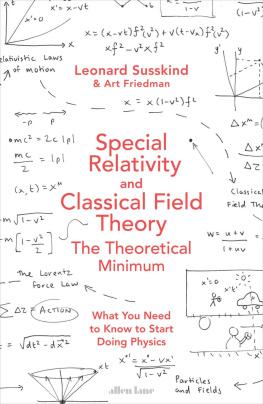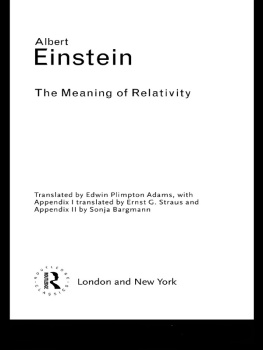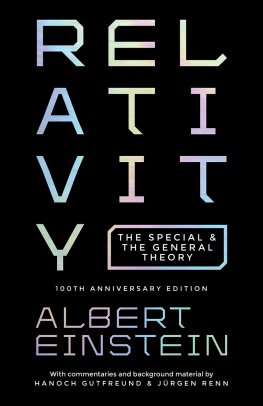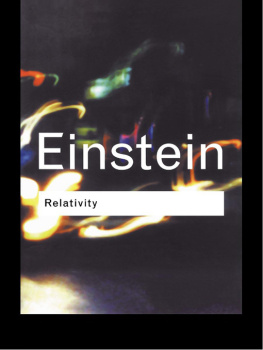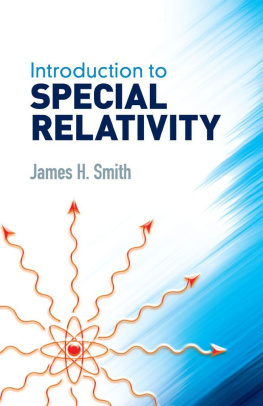This book is the third volume of the Theoretical Minimum series. The first volume, The Theoretical Minimum: What You Need to Know to Start Doing Physics, covered classical mechanics, which is the core of any physics education. We will refer to it from time to time simply as Volume I. The second book (Volume II) explains quantum mechanics and its relationship to classical mechanics. This third volume covers special relativity and classical field theory. The books in this series run parallel to Leonard Susskinds videos, available on the Web through Stanford University (see www.theoreticalminimum.com for a listing). While covering the same general topics as the videos, the books contain additional details and topics that dont appear in the videos.
Preface
This book is one of several that closely follow my Internet course series, The Theoretical Minimum. My coauthor, Art Friedman, was a student in these courses. The book benefited from the fact that Art was learning the subject and was therefore sensitive to the issues that might be confusing to the beginner. During the course of writing, we had a lot of fun, and weve tried to convey some of that spirit with a bit of humor. If you dont get it, ignore it.
The two previous books in this series cover classical mechanics and basic quantum mechanics. So far, we have not studied light, and thats because light is a relativistic phenomenona phenomenon that has to do with the special theory of relativity, or SR as well sometimes call it. Thats our goal for this book: SR and classical field theory. Classical field theory means electromagnetic theorywaves, forces on charged particles, and so onin the context of SR. Special relativity is where well begin.
Leonard Susskind
My parents, the children of immigrants, were bilingual. They taught us kids some Yiddish words and phrases but mainly reserved that language for themselves, often to say things they did not want us to understand. Many of their secret conversations were accompanied by loud peals of laughter.
Yiddish is an expressive language; its well suited to great literature as well as to daily life and down-to-earth humor. It bothers me that my own comprehension is so limited. Id love to read all the great works in the original, but frankly Id be happy enough just to get the jokes.
A lot of us have similar feelings about mathematical physics. We want to understand the great ideas and problems and engage our own creativity. We know theres poetry to be read and written, and were eager to participate in some fashion. All we lack is that secret language. In this series, our goal is to teach you the language of physics and show you some of the great ideas in their native habitat.
If you join us, youll be able to wrap your head around a good portion of twentieth-century physics. Youll certainly be equipped to understand much of Einsteins early work. At a minimum, youll get the jokes and the serious ideas that underlie them. To get you started, weve thrown in a few jokes of our own, including some real groaners.
Im delighted to acknowledge everyone who helped and supported us along the way. It may be a clich to say we couldnt have done it without you, but it also happens to be true.
Working with the professionals at Brockman, Inc., and Basic Books is always a pleasure as well as a learning experience. John Brockman, Max Brockman, and Michael Healey played a critical role in transforming our idea into a real project. From there, TJ Kelleher, Hlne Barthlemy, Carrie Napolitano, and Melissa Veronesi walked us through the editorial and production process with great skill and understanding. Laura Stickney of Penguin Books coordinated the publication of the UK edition so smoothly, we hardly saw it happening. Copyeditor Amy J. Schneider made substantial improvements to our initial manuscript, as did proofreaders Lor Gehret and Ben Tedoff.
A number of Leonards former students generously offered to review the manuscript. This was no small task. Their insights and suggestions were invaluable, and the book is far better as a result. Our sincere thanks go to Jeremy Branscome, Byron Dom, Jeff Justice, Clinton Lewis, Johan Shamril Sosa, and Dawn Marcia Wilson.
As always, the warmth and support Ive received from family and friends has seen me through this project. My wife, Maggie, spent hours creating and re-creating the two Hermanns Hideaway drawings, getting them done on time while dealing with the illness and passing of her mother.
This project has afforded me the luxury of pursuing two of my life passions at the same time: graduate level physics and fourth-grade humor. In this respect, Leonard and I are a perfect team, and collaborating with him is an unmitigated pleasure.
Art Friedman
Introduction
Dear readers and students of The Theoretical Minimum,
Hello there, and welcome back to Lenny & Arts Excellent Adventure. We last left the intrepid pair recovering from a wild rollicking roller coaster ride through the quantum world of entanglement and uncertainty. They were ready for something sedate, something reliable and deterministic, something classical. But the ride continues in Volume III, and its no less wild. Contracting rods, time dilation, twin paradoxes, relative simultaneity, stretch limousines that do and dont fit into Volkswagen-size garages. Lenny and Art are hardly finished with their madcap adventure. And at the end of the ride Lenny tricks Art with a fake monopole.
Well, maybe that is a bit overwrought, but to the beginner the relativistic world is a strange and wondrous fun house, full of dangerous puzzles and slippery paradoxes. But well be there to hold your hand when the going gets tough. Some basic grounding in calculus and linear algebra should be good enough to get you through.
Our goal as always is to explain things in a completely serious way, without dumbing them down at all, but also without explaining more than is necessary to go to the next step. Depending on your preference, that could be either quantum field theory or general relativity.
Its been a while since Art and I published Volume II on quantum mechanics. Weve been tremendously gratified by the thousands of e-mails expressing appreciation for our efforts, thus far, to distill the most important theoretical principles of physics into TTM.
The first volume on classical mechanics was mostly about the general framework for classical physics that was set up in the nineteenth century by Lagrange, Hamilton, Poisson, and other greats. That framework has lasted, and provides the underpinning for all modern physics, even as it grew into quantum mechanics.

